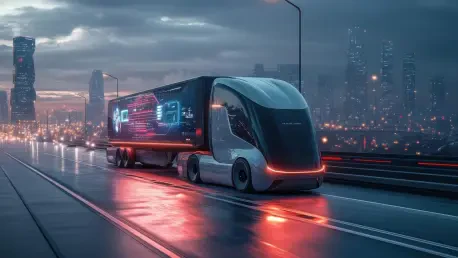I’m thrilled to sit down with Rohit Laila, a veteran in the logistics industry with decades of experience in supply chain and delivery. Rohit’s passion for technology and innovation has positioned him as a leading voice on the future of transportation, particularly in the realm of automated vehicles and self-driving trucks. Today, we’ll dive into the U.S. Department of Transportation’s recent efforts to advance autonomous trucking, exploring the challenges, opportunities, and critical research needed for a nationwide rollout. From safety concerns to data standards and public trust, Rohit will share his insights on how this technology could transform the industry.
How do you see the U.S. Department of Transportation’s recent Request for Information on self-driving trucks shaping the future of logistics?
I think it’s a pivotal step. The DOT is essentially trying to build a roadmap for deploying automated vehicles, including commercial trucks, on a national scale. By seeking input from the trucking industry, tech developers, and researchers, they’re acknowledging that this isn’t just a government project—it’s a collaborative effort. In logistics, where efficiency and safety are everything, this kind of initiative could streamline long-haul operations and reduce costs. But it’s also about figuring out what data and resources are needed to make sure these systems work seamlessly across different regions and conditions.
What’s your take on why there’s been a renewed push for autonomous trucking now, after slower progress in recent years?
Timing is a big factor. A few years back, during the first Trump administration, there was some groundwork laid with a comprehensive plan for AVs. But then progress stalled, partly due to shifting priorities and the lack of a clear regulatory framework. Now, there’s renewed political and industry pressure to move forward, especially with legislation being introduced to clarify safety rules for fully autonomous trucks. Plus, the technology has matured—sensors, AI, and connectivity are more reliable than ever. The industry is ready to test these systems at scale, and the DOT is stepping in to guide that process.
Why is interoperable digital data so crucial for automated fleets, especially in logistics?
Interoperable data is the backbone of automated fleets. Imagine a transcontinental truck journey—fueling stops, inspections, and emergency maintenance all need to happen without human intervention. If data isn’t standardized across systems, you risk delays or breakdowns. For logistics, where timing is critical, having digital data that’s compatible between trucks, infrastructure, and service providers means smoother operations. It’s about creating a language that every part of the ecosystem understands, from the vehicle to the roadside assistance network.
What kind of infrastructure data do you believe is most urgently needed to support self-driving trucks on the road?
Roadway data is at the top of the list. Automated trucks need real-time information on road conditions, construction zones, and traffic patterns to navigate safely. Detailed mapping of highways, intersections, and even parking areas—whether public or private—is essential. Without this, you’re asking a machine to guess what’s ahead, which isn’t feasible for heavy vehicles carrying valuable cargo. I’d also say data on bridge weight limits and tunnel clearances is critical for planning routes in logistics. The more precise and accessible this data is, the better.
How can research improve the interaction between self-driving trucks and other road users like pedestrians and cyclists?
This is a huge area of concern. Research needs to focus on how these trucks can predict and react to unpredictable human behavior. Pedestrians and cyclists don’t always follow rules, so AV systems must be trained on vast datasets of real-world interactions to anticipate erratic movements. Better sensor technology and machine learning can help detect and classify different road users, even in crowded urban settings. It’s also about communication—maybe visual or auditory signals from the truck to let people know its intentions. Building that trust through consistent, safe behavior is key.
What challenges stand out when ensuring automated vehicles perform reliably in adverse conditions like bad weather or sensor failures?
Adverse conditions are a massive hurdle. Rain, fog, or snow can mess with sensors, reducing visibility and accuracy. Work zones with temporary markings or potholes add another layer of complexity. The challenge is designing systems that don’t just rely on one type of input—like cameras—but integrate multiple sensors, such as radar and lidar, to cross-check data. Sensor failure or loss of network connection is equally worrying. If a truck can’t communicate with a central system, it needs robust onboard decision-making to handle emergencies. Research into redundancy and fail-safes is critical to avoid accidents.
How can we design human-machine interfaces to boost safety and trust for everyone interacting with automated vehicles?
Human-machine interfaces need to be intuitive, especially for emergency responders or other drivers who might not be tech-savvy. For responders, clear displays or voice commands on the vehicle could provide critical info—like whether the truck is fully autonomous or if there’s a human backup. For regular road users, simple visual cues, like lights or signs indicating the truck’s next move, can reduce confusion. Trust comes from transparency—people need to understand what the vehicle is doing and why. Research into user-friendly design and real-world testing with diverse groups can help refine these interfaces.
Looking ahead, what is your forecast for the future of self-driving trucks in the logistics industry over the next decade?
I’m optimistic but cautious. Over the next ten years, I expect we’ll see self-driving trucks handling more long-haul routes, especially on highways where conditions are more predictable. Advances in AI and infrastructure data will likely make this feasible, cutting down on driver fatigue and fuel costs in logistics. However, urban areas and last-mile delivery will take longer due to complex traffic and safety concerns. The key will be balancing innovation with regulation—getting the safety standards right without stifling progress. If the DOT and industry can align on data standards and public trust, we could see a real transformation in how goods move across the country.









